Photo Essay: Canvasbacks
A photo essay documenting the grace and elegance of North America's king of ducks
A photo essay documenting the grace and elegance of North America's king of ducks
Revered by old-time waterfowlers as the King of Ducks, the noble canvasback has every trait a duck hunter can admire. It is large bodied, yet sleek and elegant. The scarlet head of the male is held high, and its striking blood-red eyes are unmistakable. The name "canvasback" is derived from the dusty white feathers on its back and sides. English settlers along the Atlantic coast thought these feathers looked like white canvas fabric.
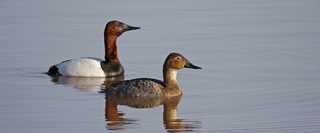
Photo © Michael Furtman
With swift wing beats, canvasbacks are one of the fastest ducks in the sky, but the trade-off is that they are very slow and clumsy on land. Because their feet are placed far back on their body for swimming and diving, the canvasback has difficulty walking on land and cannot quickly lift off the water like a mallard. Instead, the canvasback must flap its wings and get a running start over the water's surface before taking flight.
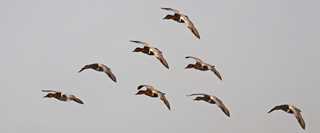
Photo © Michael Furtman
Most canvasbacks breed in the Prairie Pothole Region, but some will nest as far north as Alaska. Canvasback hens prefer to nest on heavily vegetated ponds with deep enough water to provide some protection from land-based carnivores like skunks and foxes.

Photo © Michael Furtman
Canvasbacks and other diving ducks have suffered from the deterioration of water quality in North America. In many places of former importance to these birds, their preferred submersed aquatic plants have been lost to increased turbidity caused by soil erosion, rough fish, and industrial pollution. In other places like San Francisco Bay and certain spots in the Great Lakes, chemical contaminants are accumulating in wintering and migrating diving ducks. On the breeding grounds, wetland drainage and filling continue to be the main threat to canvasbacks and redheads.
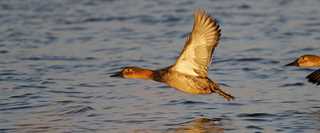
Photo © Michael Furtman
With conservative regulations in place to help ensure a sustainable harvest, fewer people hunt "King Can" than once did. But because of the species' restricted distribution and the challenge of hunting their wide-open haunts, cans were never everyman's duck like mallards are. But everyone should witness once in their lifetime the thrill of a flock of cans ripping over decoys on a crossing wind.
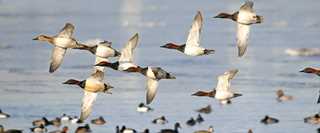
Photo © Michael Furtman
The startling roar of wind through a hundred wings. The surprising snap of feathers straining against the air and the force of a duck trying to change direction fast. Dazzling white plumage against indigo water in the evening light.
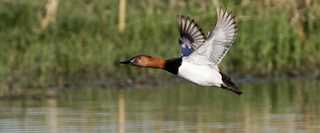
Photo © Michael Furtman
Conserving canvasbacks is all about conserving wetlands-something Ducks Unlimited has been doing in the United States and Canada since 1937. On the prairies, DU is working with many partners to protect small potholes and larger wetlands that support the majority of breeding canvasbacks and many other waterfowl species.
On key canvasback migration and wintering areas, DU and partners are working to improve water quality in high-priority watersheds like the Great Lakes; Chesapeake Bay; the Illinois and Mississippi rivers; coastal North and South Carolina; San Francisco Bay, and the Gulf Coast. Good water quality ensures healthy production of submersed aquatic plants and abundant canvasback food.

Photo © Michael Furtman
May we always have the opportunity to meet these legendary birds up close and personal! But this shall only be so if we look after the wetlands that sustain canvasbacks across our continent. Just like a flight of cans arrowing through an autumn wind, our course is clear. Let us not fail the birds, or future generations, in our resolve

Photo © Michael Furtman
For more information on how you can help conserve vital wetland habitat for canvasbacks and other waterfowl, click here.